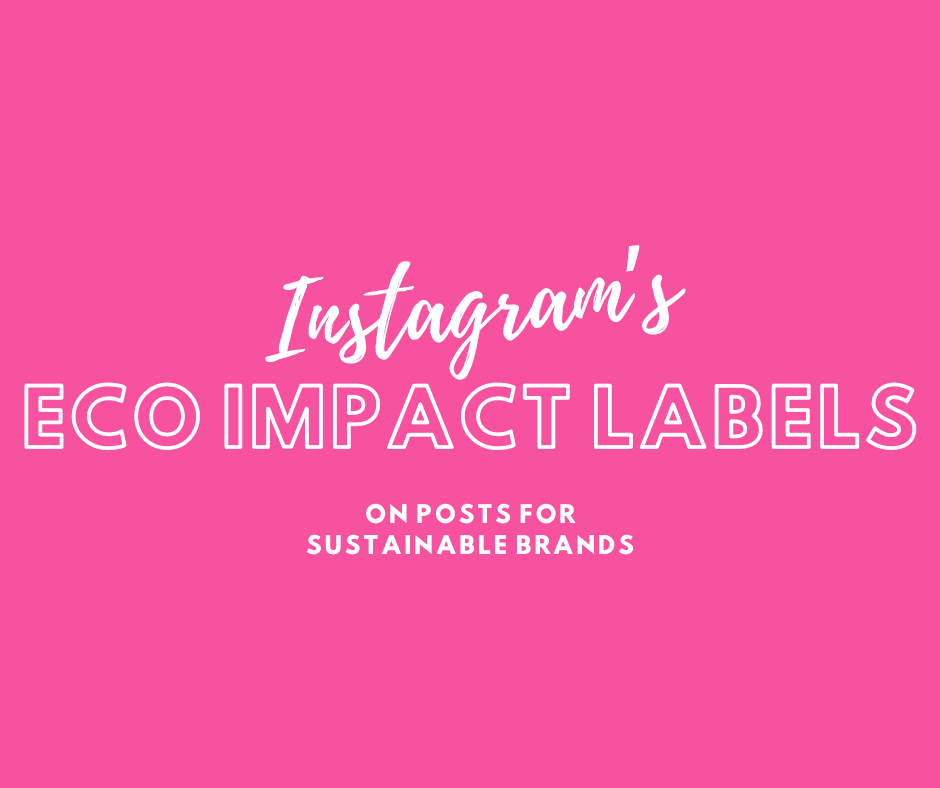Last Updated on March 27, 2025 by Val Razo
In the evolving landscape of social media marketing, sustainability is no longer a buzzword — it’s a business imperative. As brands on social media look to engage a more conscious audience, tools like Instagram’s eco impact labels offer a powerful way to promote eco-friendly products, showcase sustainability initiatives, and foster consumer trust. Especially for sustainable fashion brands and eco-fashion brands, this feature helps convey a brand’s commitment to sustainability in a format that resonates with today’s values-driven shoppers.
With platforms like Instagram becoming central hubs for storytelling, it’s crucial for brands to communicate their sustainability efforts authentically. Whether you’re a clothing brand just starting out or an established name seeking to leverage user-generated content, these labels present a chance to align your brand values with real environmental and social impact.
In this guide, we’ll break down how to implement Instagram’s eco impact labels on posts for sustainable brands, helping you not only navigate the feature but also curate a strategy that reinforces your brand’s mission and values while driving higher engagement.
Why Sustainability and Social Media Go Hand-in-Hand
In today’s digital landscape, sustainability is deeply intertwined with the way brands use social media. As environmental issues take center stage in global conversations, more users expect the brands they support to not only offer eco-friendly products but to demonstrate real sustainable practices across their marketing. This is where the power of social media becomes vital — not just for visibility, but for leading with purpose.
How Social Media Marketing Supports Sustainable Fashion Brands
For sustainable fashion brands, platforms like Instagram and TikTok aren’t just about showcasing products — they’re tools for driving positive social and environmental change. Through strategic social media marketing, brands can educate followers on their supply chains, promote fair trade and organic materials, and share updates on sustainability initiatives in real time.
More importantly, these channels allow brands to authentically express their brand identity and values, which are often rooted in social responsibility. By creating visual content that highlights efforts to fight against climate change or source sustainable materials, brands inspire a deeper level of trust and loyalty.
The Role of Eco-Friendly Content in Building a Sustainable Brand
Creating an authentic brand today means more than just selling — it’s about fostering engagement through storytelling. Posts that spotlight eco-friendly choices, behind-the-scenes looks at sustainability practices, or community-driven campaigns (like “plants a tree” initiatives) can resonate with conscious consumers.
Additionally, the use of hashtags like #SustainableLiving, #EcoFashion, or #FairTradeFashion helps brands join a larger movement, increasing discoverability and allowing consumers to find brands to elevate and support. Educational caption writing and purposeful Instagram content also signal transparency — a trait that today’s audiences associate with authenticity and social good.
Ultimately, by integrating sustainability and marketing, brands aren’t just creating content — they’re leading a conversation. And for fashion brands, this blend of sustainable messaging and social proof can drive both business performance and meaningful change.
In 2023, Patagonia launched a major Instagram campaign centered around its “We’re in Business to Save Our Home Planet” mission. The brand integrated eco impact labels across its Instagram product posts and ran a parallel educational Stories series featuring their supply chain transparency, recycled materials, and regenerative farming practices.
The campaign generated:
A 28% increase in engagement
Over 10K shares on their sustainability Stories series
Notable uptick in user-generated content featuring eco labels
Understanding Instagram’s Eco Impact Labels
As digital platforms evolve, so does the demand for transparency in how brands communicate their sustainability efforts. That’s why Instagram introduced eco impact labels — a feature designed to help brands on social media highlight their environmental footprint and showcase verified sustainable practices. For brands genuinely invested in sustainability, this is a game-changer.
What the Eco Impact Labels Mean for Eco-Fashion Brands
For eco-fashion brands and sustainable fashion brands, the ability to include sustainable labels on an Instagram post offers more than just visual flair — it’s a signal of accountability. These labels indicate that the brand has taken concrete steps toward reducing its environmental impact, using sustainable materials, or following ethical production standards.
The labels are often tied to recognized initiatives or certifications, allowing consumers to easily identify when a clothing brand is making genuine efforts versus just making sustainability claims. In an era where greenwashing is rampant, this distinction helps consumers support companies whose values truly align with theirs.
Why Brands Need to Use Instagram’s Sustainability Tools
The opportunity for brands to raise awareness through Instagram content is massive — especially when it comes to sustainability related topics. Instagram’s eco impact labels serve as social proof, boosting engagement rates and helping brands to elevate their message with credibility.
Moreover, brands need to use these tools not just to look good, but to lead. They give companies a platform to reinforce their brand’s mission and values, and to participate in larger movements around social and environmental activism. When used effectively, these tools allow a brand to curate a visual presence that shows genuine commitment to sustainability — and that’s exactly what conscious consumers are looking for.
As the founder of a small sustainable clothing brand, adding Instagram’s eco impact labels to our posts felt like a natural extension of our values. Our audience loved the transparency, and within the first month, our engagement on eco-tagged posts went up by nearly 30%.
How Sustainable Brands Can Implement Eco Impact Labels
Implementing Instagram’s eco impact labels isn’t just about ticking a box — it’s about aligning your brand identity with your commitment to sustainability in a way that’s visible, verifiable, and impactful. Whether you’re a new clothing brand or a well-established name in the fashion industry, the process starts with intentionality.
Step-by-Step Process for Applying Labels to Instagram Content
-
Get Verified or Certified
Instagram’s eco labels are tied to third-party environmental certifications or sustainability initiatives. Ensure your brand is aligned with recognized programs like Fair Trade, GOTS (Global Organic Textile Standard), or other eco-certifications relevant to your industry. -
Update Your Business Profile
On platforms like Instagram, you’ll want to clearly display your eco credentials in your bio and use the “About” section to highlight your sustainability practices, materials used, and mission. -
Tag Sustainable Products or Posts
When creating an Instagram post or Instagram Story, you’ll have the option to include eco labels — typically under the “product tags” or through built-in brand tools. This is where your certification or sustainable claim will appear directly on the content. -
Use Supporting Features
Combine these labels with user-generated content, behind-the-scenes visual content, or even educational content that shows how your brand is making a meaningful change. This helps reinforce authenticity and increases your post’s engagement rate. -
Monitor and Refine
Track metrics like impressions, saves, and shares to see which types of sustainability and marketing content your audience responds to most. Use these insights to refine your social media strategy and increase visibility across multiple social media channels.
Strategies for Sustainable Brands to Leverage Instagram Stories and Posts
Instagram Stories are a great way for sustainable fashion brands to share updates in real-time. You can use them to showcase eco-friendly choices, promote new sustainable products, or highlight your supply chains and production process. Don’t forget to use stickers, polls, and hashtags that resonate with your audience’s interest in sustainable living.
When creating posts, focus on authentic storytelling. Incorporate sustainability claims thoughtfully, avoid over-explaining, and let the visuals do the talking. If your brand has a “plants a tree” initiative, show it. If you source materials locally, talk about the artisans. These details create a deeper connection and build lasting consumer trust.
Influencer Marketing for Sustainable Fashion
Influencer marketing is one of the most effective ways for sustainable fashion brands to spread awareness, drive engagement, and create authentic conversations around sustainability. When brands leverage the right personalities who resonate with their mission, they tap into loyal audiences who care deeply about social good and eco-friendly choices.
Choosing the Right Influencers for a Sustainable Clothing Brand
Finding the right influencers starts with alignment. You’re not just looking for people with big followings — you’re looking for individuals who walk the talk. These influencers live by sustainable practices, talk about environmental issues, and support causes related to sustainable living.
Look for:
-
Micro-influencers with strong engagement rates in the sustainability or eco-fashion niche
-
Creators who actively support sustainability initiatives or highlight eco-friendly products
-
Influencers who are transparent about paid promotions and maintain consumer trust
It’s also important that the influencer’s aesthetic, tone, and audience align with your brand’s mission and values — especially if you’re a clothing brand in a niche like slow fashion or fair trade and organic.
In 2023, over 40% of sustainable fashion brands actively used Instagram’s eco impact features to highlight certifications, materials, and ethical practices.
How Influencers Promote Social Good Through Instagram
Influencers play a key role in turning your brand’s sustainability claims into relatable, lived experiences. Through Instagram Stories, photos or videos, or “a day in the life” content, they help brands to elevate awareness around your environmental and social efforts.
Whether it’s unboxing an eco-friendly product, walking through your supply chains, or sharing content that highlights your sustainability practices, these collaborations create powerful user-generated content. It shows the product in action and ties it directly to values like activism, transparency, and corporate social responsibility.
Plus, influencers can introduce your brand to audiences you might not reach on your own — creating an opportunity for brands to grow with intention and credibility.
Long-Term Social Media Strategy for Eco-Friendly Growth
For sustainable fashion brands, building a strong presence on social media platforms like Instagram isn’t just about momentary trends — it’s about creating lasting, purpose-driven engagement. A well-crafted social media strategy grounded in sustainability practices can turn your audience into advocates and your content into a catalyst for meaningful change.
Social Media Strategies for Sustainable Fashion Brands
The first step is to create a strategy that aligns with your brand values and long-term goals. Here are key pillars every eco-fashion brand should incorporate:
-
Educational Content: Share insights about sustainable materials, supply chains, and the environmental impact of the fashion industry. Content that educates encourages shares and boosts your engagement rate.
-
Visual Storytelling: Use photos or videos that show behind-the-scenes production, workers, and your commitment to sustainability. People connect with visuals — especially when they tell a story around social responsibility.
-
Sustainable Messaging in Captions: Be clear, concise, and authentic in every caption. Talk about what your brand stands for and how your audience can participate in your initiatives.
-
Engage Through Community: Encourage customers to share their own content. Create campaigns that highlight everyday people making eco-friendly choices with your products. This boosts user-generated content and builds social proof.
-
Consistency Across Social Media Channels: From Instagram to TikTok, make sure your sustainable messaging is consistent. Many social media platforms offer features that let you showcase your sustainability initiatives, so brands are using these tools to amplify their message and stand out.
As a sustainability-focused fashion influencer, I look for brands that walk the talk. When I see eco impact labels on a brand’s Instagram post, it makes it easier for me to promote their products authentically — and my followers are more likely to trust it.
How Brands on Social Media Can Maximize Engagement for Sustainability
To grow your platform and make a lasting impact, focus on creating social content that reflects your brand’s identity and promotes your sustainability efforts. This includes:
-
Hosting live Q&As about sustainability claims
-
Running Story polls related to eco-friendly choices
-
Partnering with NGOs or planting trees as part of your activism
Ultimately, the goal is to build a community around your brand’s mission and values, one that’s inspired to act and share your brand’s values. That’s the kind of influence that goes beyond likes — it creates real-world impact.
73% of Gen Z consumers say they are more likely to purchase from a brand that promotes sustainability on social media.
Conclusion
As consumers continue to prioritize sustainability, brands that take real action and communicate it clearly are the ones making the greatest impact — both socially and commercially. By learning how to implement Instagram’s eco impact labels on posts for sustainable brands, you’re not just staying ahead in the fashion industry, you’re becoming part of the solution.
Whether through Instagram Stories, impactful visual content, or strategic influencer marketing, your brand has countless opportunities to connect with a community that values authenticity, social good, and real sustainability practices. The key is to stay transparent, stay consistent, and stay committed to your brand’s mission and values.
In the end, this is more than just a marketing strategy — it’s a movement. And by embracing tools like eco impact labels, your brand can lead it.
Frequently Asked Questions
How can sustainable brands stand out from fast fashion competitors on Instagram?
To stand out from fast fashion brands, sustainable companies need to double down on transparency and storytelling. This means sharing behind-the-scenes processes, sourcing ethics, and the long-term environmental benefits of their products. Unlike fast fashion, sustainability is a story — and Instagram is the perfect platform to tell it through visuals, captions, and authentic interaction.
What are some of the best sustainable practices for brands using Instagram?
Some of the best sustainable Instagram practices include: using eco impact labels, educating your audience about your supply chain, spotlighting ethical partnerships, and encouraging customers to share their own sustainability stories. These tactics not only boost engagement but help your brand become a voice for change in the fashion space.
What types of content do brands like Patagonia share to communicate sustainability?
Brands like Patagonia share a mix of educational, values-driven, and behind-the-scenes content. This includes everything from climate-focused campaigns (like their “we’re in business to save our home planet” message) to factory tours, product sourcing highlights, and collaborative efforts with NGOs. Their content is mission-first and visually striking — a great model for other eco-minded brands.
How can brands use Instagram to increase interest in sustainability among their followers?
To spark interest in sustainability, brands should focus on engaging and informative content. Think quizzes in Stories, sustainability myth-busting Reels, or carousel posts showing the impact of conscious choices. The more interactive and shareable your content is, the more likely it is to resonate with an audience curious about topics related to sustainability.
Why are so many brands embracing eco impact tools on Instagram now?
Many brands are adopting Instagram’s eco tools because consumers demand transparency and accountability more than ever. Features like eco impact labels help brands showcase verified claims and set themselves apart from greenwashing competitors. It’s also a simple but powerful way to build long-term trust and social proof with sustainability-minded audiences.
Author Bio
Val Razo
Val Razo is a skilled professional in the field of Instagram Marketing. With over five years of experience as a freelance Social Media Marketing consultant, Val has assisted numerous small and medium-sized businesses in achieving their goals.




